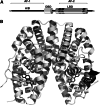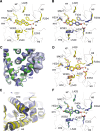A structural view of nuclear hormone receptor: endocrine disruptor interactions
- PMID: 20063036
- PMCID: PMC11115495
- DOI: 10.1007/s00018-009-0249-2
A structural view of nuclear hormone receptor: endocrine disruptor interactions
Abstract
Endocrine-disrupting chemicals (EDCs) represent a broad class of exogenous substances that cause adverse effects in the endocrine system by interfering with hormone biosynthesis, metabolism, or action. The molecular mechanisms of EDCs involve different pathways including interactions with nuclear hormone receptors (NHRs) which are primary targets of a large variety of environmental contaminants. Here, based on the crystal structures currently available in the Protein Data Bank, we review recent studies showing the many ways in which EDCs interact with NHRs and impact their signaling pathways. Like the estrogenic chemical diethylstilbestrol, some EDCs mimic the natural hormones through conserved protein-ligand contacts, while others, such as organotins, employ radically different binding mechanisms. Such structure-based knowledge, in addition to providing a better understanding of EDC activities, can be used to predict the endocrine-disrupting potential of environmental pollutants and may have applications in drug discovery.
Figures






References
-
- Swedenborg E, Ruegg J, Makela S, Pongratz I. Endocrine disruptive chemicals: mechanisms of action and involvement in metabolic disorders. J Mol Endocrinol. 2009;43:1–10. - PubMed
-
- Tabb MM, Blumberg B. New modes of action for endocrine-disrupting chemicals. Mol Endocrinol. 2006;20:475–482. - PubMed
-
- Janosek J, Hilscherova K, Blaha L, Holoubek I. Environmental xenobiotics and nuclear receptors: interactions, effects and in vitro assessment. Toxicol In Vitro. 2006;20:18–37. - PubMed
Publication types
MeSH terms
Substances
LinkOut - more resources
Full Text Sources

